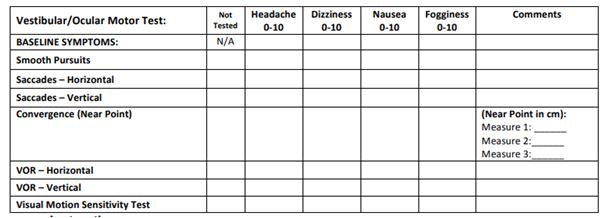Vestibular Oculomotor Motor Screening (VOMS) Assessment: Difference between revisions
No edit summary |
No edit summary |
||
| Line 6: | Line 6: | ||
</div> | </div> | ||
== Introduction == | == Introduction == | ||
Impairments in the vestibulo-ocular system commonly manifest as symptoms of dizziness and visual instability.Nearly 30% of concussed athletes report visual problems during the first week after the injury.<ref name=":0">Kontos AP, Elbin RJ, Schatz P, et al. A revised factor structure for the Post-Concussion Symptom Scale: baseline and postconcussion factors. Am J Sports Med. 2012;40(10):2375-2384.</ref> Ocular motor impairments and symptoms may manifest as blurred vision, diplopia, impaired eye movements, difficulty in reading, dizziness, headaches, ocular pain, and poor visual-based concentration.<ref>Ciuffreda KJ, Ludlam D, Thiagarajan P. Oculomotor diagnostic protocol for the mTBI population. Optometry. 2011;82(2):61-63.</ref> Dizziness, which may represent an underlying impairment of the vestibular and/or ocular motor systems, is reported by 50% of concussed athletes<ref name=":0" /> and is associated with a 6.4-times greater risk, relative to any other on-field symptom, in predicting protracted (>21 days) recovery.<ref>Lau BC, Kontos AP, Collins MW, Mucha A, Lovell MR. Which on-field signs/symptoms predict protracted recovery from sport-related concussion among high school football players? Am J Sports Med. 2011;39(11):2311-2318.</ref> | |||
== | [[Concussion]]<nowiki/>s can directly impair oculomotor function. Ocular issues (poor eye tracking) after concussion are common. Specifically cranial nerves (CN) III, IV and VI which innervate the eye muscles are susceptible to injury anywhere along the route from brainstem to eye muscles, so this needs to be assessed. | ||
== Vestibular/Ocular-Motor Screening (VOMS) for Concussion == | |||
This test is designed for use with subjects ages 9-40. When used with patients outside this age range, interpretation may vary. | |||
''Equipment:'' Tape measure (cm), Target with a 14 point font print. | |||
[[File:Vestibular Ocular-Motor Screening.JPG]] | |||
== Sub Heading 3 == | == Sub Heading 3 == | ||
== Resources == | == Resources == | ||
[https://www.bamc.org/media/1393/voms-exam.pdf Vestibular/Ocular-Motor Screening (VOMS) for Concussion] | |||
Revision as of 16:04, 2 September 2019
Original Editor - Megyn Robertson
Top Contributors - Simisola Ajeyalemi, Kim Jackson, Rachael Lowe, Shaimaa Eldib, Mandy Roscher, Stacy Schiurring, Megyn Robertson, Samuel Adedigba, Jess Bell, Olajumoke Ogunleye and Nupur Smit Shah
Introduction[edit | edit source]
Impairments in the vestibulo-ocular system commonly manifest as symptoms of dizziness and visual instability.Nearly 30% of concussed athletes report visual problems during the first week after the injury.[1] Ocular motor impairments and symptoms may manifest as blurred vision, diplopia, impaired eye movements, difficulty in reading, dizziness, headaches, ocular pain, and poor visual-based concentration.[2] Dizziness, which may represent an underlying impairment of the vestibular and/or ocular motor systems, is reported by 50% of concussed athletes[1] and is associated with a 6.4-times greater risk, relative to any other on-field symptom, in predicting protracted (>21 days) recovery.[3]
Concussions can directly impair oculomotor function. Ocular issues (poor eye tracking) after concussion are common. Specifically cranial nerves (CN) III, IV and VI which innervate the eye muscles are susceptible to injury anywhere along the route from brainstem to eye muscles, so this needs to be assessed.
Vestibular/Ocular-Motor Screening (VOMS) for Concussion[edit | edit source]
This test is designed for use with subjects ages 9-40. When used with patients outside this age range, interpretation may vary.
Equipment: Tape measure (cm), Target with a 14 point font print.
Sub Heading 3[edit | edit source]
Resources[edit | edit source]
Vestibular/Ocular-Motor Screening (VOMS) for Concussion
References[edit | edit source]
- ↑ 1.0 1.1 Kontos AP, Elbin RJ, Schatz P, et al. A revised factor structure for the Post-Concussion Symptom Scale: baseline and postconcussion factors. Am J Sports Med. 2012;40(10):2375-2384.
- ↑ Ciuffreda KJ, Ludlam D, Thiagarajan P. Oculomotor diagnostic protocol for the mTBI population. Optometry. 2011;82(2):61-63.
- ↑ Lau BC, Kontos AP, Collins MW, Mucha A, Lovell MR. Which on-field signs/symptoms predict protracted recovery from sport-related concussion among high school football players? Am J Sports Med. 2011;39(11):2311-2318.







